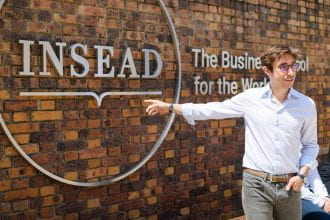Scottish alumni commission the design of an exclusive tartan for INSEAD
When news of INSEAD’s no. 1 Financial Times’ ranking broke, a small group of Scottish alumni had a thought: Why not seize this opportunity to celebrate the school with the most iconic gift Scotland could offer — an INSEAD tartan?
“We thought it would be neat if INSEAD, as the business school for the world, had its own tartan as a way of creating a visual identity,” said Graham Hastie MBA’95J, assistant dean of Degree Programmes at INSEAD, who lead the tartan project along with Gillian Watson MBA’94 and Paul Skipworth MBA’95J, president of the UK Alumni Association. “The idea was to show appreciation for and recognition of the ranking.”
Commissioning the design of a tartan, however, is no small undertaking. There are only about 7,000 tartans that exist in the world today — each with its own exclusive, one-of-a-kind design — and creating a new tartan involves a methodical process that must be led by an official tartan designer.
For this small group of alumni, however, this was quickly deemed a worthy endeavour. “Having our own tartan reinforces the global family that you become a part of when you become an INSEAD alum,” said Gillian. “It becomes something that unites the alumni.”
Creating a fabric of significance
As a fir st step in the process, the team emailed Scottish alumni based all around the world — including those in Asia, Africa, Australia, North America and the Middle East — to gauge interest in the project and raise funds for it. Many rallied behind the idea as sponsors.
st step in the process, the team emailed Scottish alumni based all around the world — including those in Asia, Africa, Australia, North America and the Middle East — to gauge interest in the project and raise funds for it. Many rallied behind the idea as sponsors.
Once the team had completed the fundraising phase, it selected Kinloch Anderson, the foremost expert in tartan and Highland Dress, to design and supply the tartan. Founded in 1868, Kinloch Anderson has a long history of serving as a tailor to the Royal Family, dating back to King Edward VII in 1903. It currently serves as the appointed tailor and kilt makers of HM The Queen, HRH The Duke of Edinburgh and HRH The Prince of Wales.
To develop the design, Kinloch Anderson’s Deirdre Kinloch Anderson met with Graham, Gillian and Paul to gain an understanding of INSEAD’s historic background and establish links between the school and Scotland. Based on that information, she and the Kinloch Anderson team developed several options for patterns and colours that were rooted in symbolic meaning.
The final design selected by the Scottish alumni features two shades of green yarn to reflect the INSEAD brand and the forests of Fontainebleau. To acknowledge a link between Scotland and France, the pattern took inspiration from the Royal Stewart tartan, as Mary Queen of Scots reigned as Queen Consort of France from 1559-1560. The design pattern also incorporates elements from the Clan Farquharson tartan because Major-General William Farquhar was the first British resident and commandant of Singapore, and thus has ties to INSEAD’s Singapore campus. Finally, the gold yarn has three-fold significance: It symbolises INSEAD’s academic excellence, reflects the school’s connections to Abu Dhabi and celebrates the historical Financial Times ranking.
“Tartan is a design with a meaning, a personal significance, a sense of belonging and a special relevance,” explains Deirdre, noting that the earliest written mention of tartan dates back to 1538. “It communicates so much in just a glance.”
In May, the INSEAD tartan became official when it was added to The Scottish Register of Tartans.
Unveiling the INSEAD tartan
On 3 June, the INSEAD tartan was gifted to Dean Ilian Mihov at the conclusion of the Alumni Forum in London. During a presentation ceremony, the Scottish alumni also surprised the dean with a custom-made kilt.
“To our delight, llian immediately dressed in his kilt for dinner and wore it the next evening as well,” says Graham, who also had a kilt made for the event. Paul wore “trews,” or Scottish trousers, made out of the INSEAD tartan.
Reflecting on the event , Dean Mihov shares, “It was an incredible honour to receive such a generous and meaningful gift from our Scottish alumni. It brings me great joy to know that the INSEAD community will be able to wear this pattern, which carries so much meaning and significance for our institution, for all time to come.”
, Dean Mihov shares, “It was an incredible honour to receive such a generous and meaningful gift from our Scottish alumni. It brings me great joy to know that the INSEAD community will be able to wear this pattern, which carries so much meaning and significance for our institution, for all time to come.”
Graham hopes that this gesture by the Scottish alumni will encourage other alumni groups to consider how they might create something for INSEAD that carries cultural significance. “It would give me great pleasure if, for example, the French alumni made a cheese for INSEAD or the Pakistani alumni created a shawl for the school,” he says. “I encourage alumni to think about how they might contribute to the school in a way that reflects their own culture and pride in the institution.”
Editor’s note: INSEAD’s Scottish alumni host a series of events and gatherings for graduates throughout the year. Event announcements are distributed through the Scottish alumni email listserv. To sign up for the listserv, please email Gillian Watson at gillianamwatson@btinternet.com


